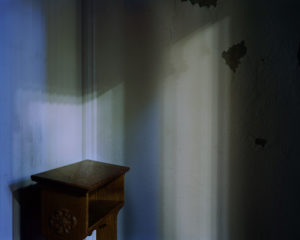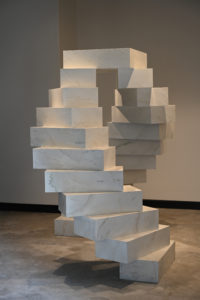Tom Gick was born and raised on a farm in Indiana by devout Catholic parents, often escaping into the vast surrounding fields. He attended Purdue University and began writing and eventually painting. After years of traveling, he settled in Massachusetts and then Maine, where he has lived for the past thirty-five years. Over the past decades he has produced dozens of major paintings, often at large scale using household materials. After choosing not to sell or exhibit his works for many years, he is now preparing for multiple exhibitions.
Image: Your work comes from a deeply personal place. Years ago, you had a profound experience that shaped you both spiritually and artistically. Could you describe that?
TG: I could not remember ever working figuratively in my early years. Then, to my shock, my grandmother poured through me, an experience somehow so frightening that I fled the studio for over a year. I sensed I was painting a presence that knew everything about me, and that I was being radically exposed, that she had come to put an end to love that hurts.
The following year I reentered the studio to die. After fifteen days-unable to eat or sleep, my mind desperately trying to give solace to my broken life-I finally collapsed and gave up my life in radical surrender. From the base of my spine, a river of orgiastic fire swept up my body and crashed into my skull. And ecstasy and love poured over me. This continued weekly for eight years, a literal dying of body and mind transforming all that is real. And all I could do was abide, as words and paintings poured out.
Image: Has your grandmother remained a presence in your work?
TG: I rarely painted this grandmother figure again, but I began painting a younger female figure. I sometimes think of them as grieving mother and lost daughter. But I am often mistaken in trying to name what is unnamable.
Image: In your studio is a massive canvas that merges image and text. It crosses genres, from poetry to prayer. Can you describe that work and share some of what you wrote?
TG: The script was originally written during my second night in the hospital as a doctor was trying to tranquilize me back to the world. Without thought, page after page poured out as fast as I could write. I think it says in raw and simple words all I will ever come to know or desire. Years later, I transcribed it onto this huge canvas, adding a later poem that is perhaps a response to its prayer. I have recently come to believe that this text is the voice of the grandmother singing solace beyond transformation:
Through Union to Hope to Liberty,
welcome home, Holy Spirit,
to the open palm holding the field of our being.
And it is all alright,
for you could not have known
it is impossible to hurry.
Image: What is your working process like? Do you think about or plan the imagery in advance, or does it tend to emerge gradually?
TG: I rarely sketch or draw. Many of my canvases begin with words, later concealed with layers of translucent color. While I work, I know not what I am doing. Only as it emerges do I bring my mind and heart to the process, wishing only to help beauty to abide. It is my only answer to exploration, to the shock of what is unknowable and unnamable: unity with the divine.
Image: I know Rothko is a major influence for you. There are some parallels between you, both in how he seeks to encompass viewers in color and in his predilection for dark, smoky forms. When did you begin to notice Rothko’s influence?
TG: Years ago I first saw a large golden canvas of Rothko’s. What most struck me was the sheer beauty of the surface. This surface beauty that invites embrace is what I most care about and hope to achieve. For it is intimacy one most relishes, to look into another’s eyes and know.
Image: Have any other painters had a similarly powerful effect on your practice?
TG: I have perhaps intentionally not exposed myself to much art. Early on, I remember being startled and captivated by the later water lily paintings of Monet. And certainly I would add Rembrandt and Vermeer.
Image: It’s interesting that you look to a paragon of abstraction, Rothko, but also great figurative masters. It feels to me like your work hovers between abstraction and figuration. Is that how you would frame it?
TG: I don’t think I move between abstraction and figuration. “At the edge of flesh beauty waits,” I once wrote in my poem “Flight of the Lark.” The years of painting abstractly have determined the tools I use-house brushes, rollers, even my fingers pushing flesh into image whether abstract or figurative.
Image: To me, your works evoke a strong visionary tradition in Western theology, especially Christian mysticism. What kinds of spiritual sources have you been drawn to over the years?
TG: I spent years reading all I could find about kundalini experiences. Much of the literature warns of the damage they can cause unless one is prepared by years of guidance and spiritual practice. I had neither. A spontaneous eruption can lead to madness.
I was deeply influenced early on by Jung’s alchemical studies, among others. Recently I mostly avoid “spiritual” texts and instead turn to poetry, which after all was one of my first loves. I think of Rimbaud, Rilke, Crane, Poe, and T.S. Eliot.
Image: You tend to work in relative isolation. How has the physical space and environment in which you work shaped your creative practice?
TG: For many reasons, I live and work in isolation. Maine has been a place of refuge, a surround like the embrace of a grandmother, her forests and mountains like hands gently shielding eyes from the blinding splendor of creation.
Image: You have seldom exhibited your works. What kind of home do you envision for them? Where would they find kindred spirits?
TG: I have no idea. Hopefully a place that offers solace.












